Act I – Sunday, August 12, 2018 – Noon – A Brush with Koshien
Koshien Stadium, near Osaka, Japan
It’s hot.
This was the first thought that crossed my mind after stepping off an air conditioned Hanshin Line train at Koshien Stadium. As I descended the station’s steps, an overwhelming scene unfolded before me – thousands of people standing in various lines snaking around as far as the eye could see, under the interstate underpass and towards Koshien Stadium.
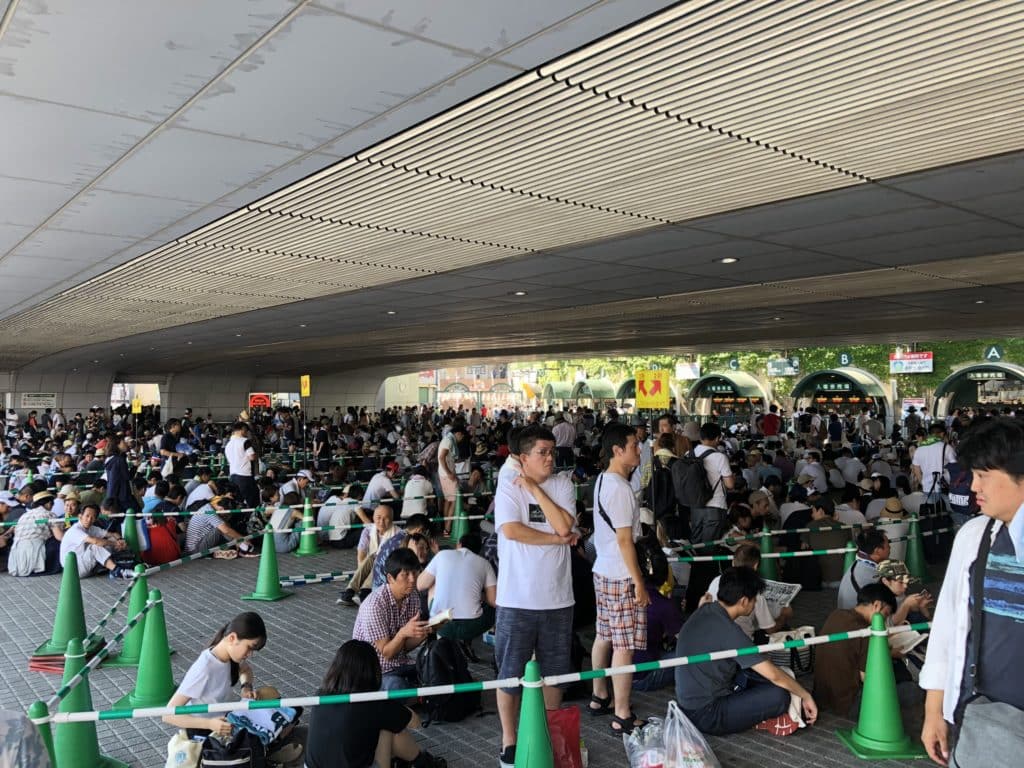
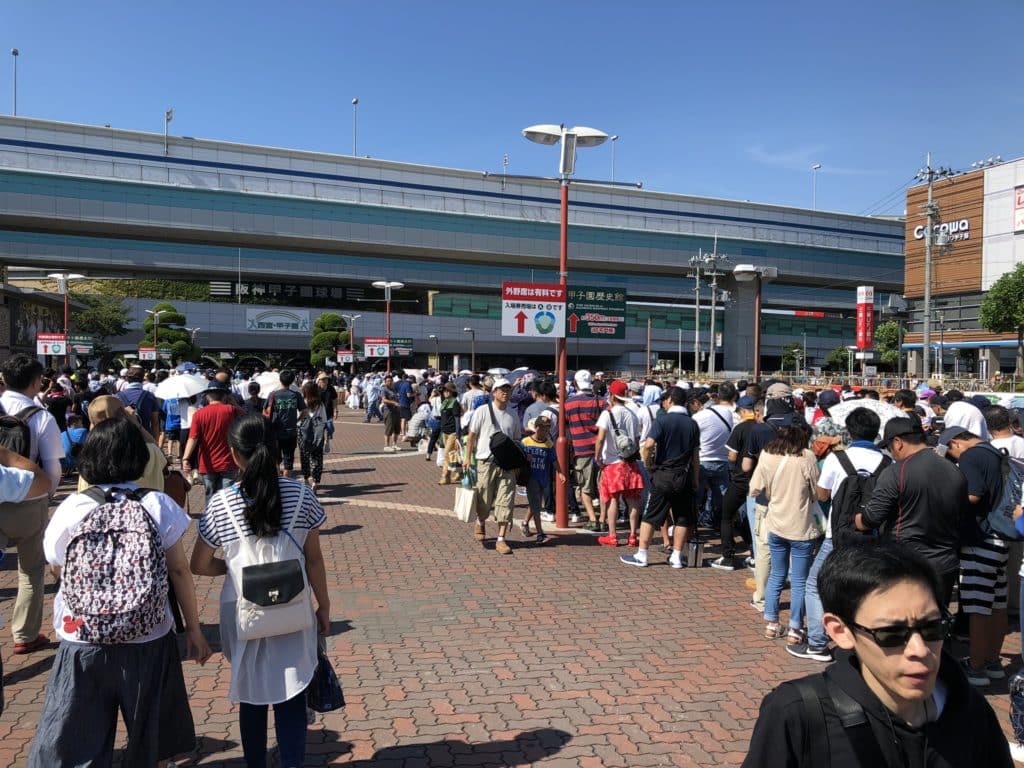
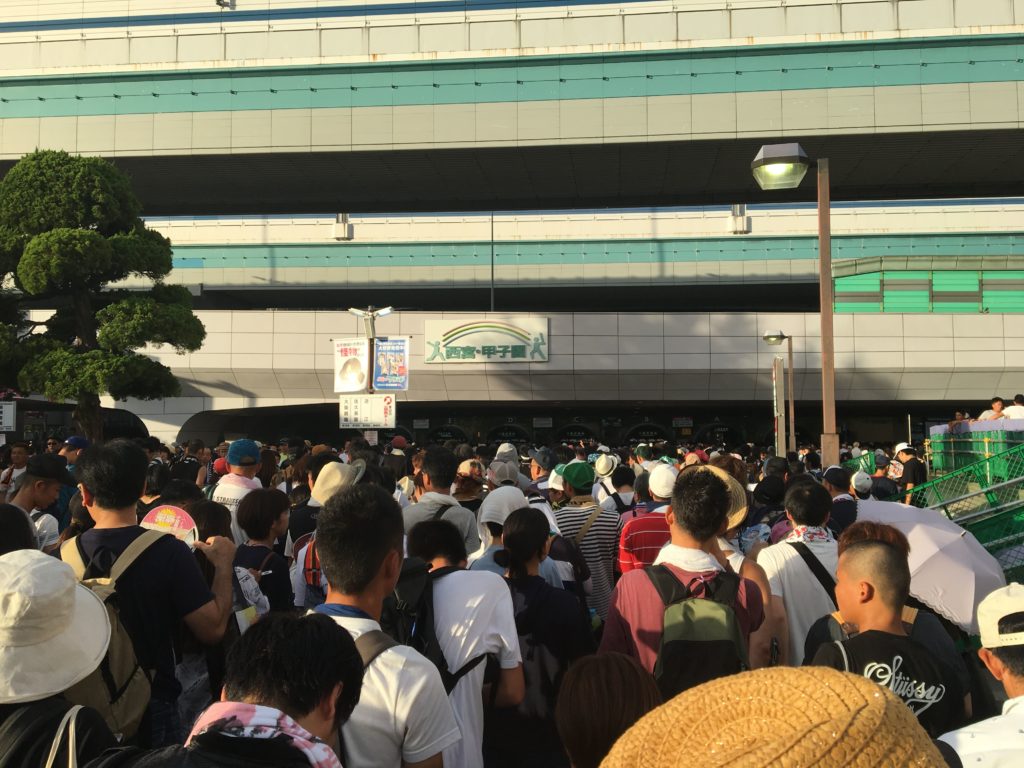
I had come all this way on my own from the USA to Koshien Stadium in an attempt to attend the 100th-anniversary high school championship tournament, simply referred to as “Koshien.” I had previously heard about Koshien from friends – they described it as the ultimate amateur Japanese baseball event. After rushing from Tokyo to Osaka, standing in the aisle of a packed Hikari Express Shinkansen train, quickly stopping to drop my bags at a station luggage bin, I had made my way to Koshien Stadium.
Now, I needed to figure out how to get in.
Stadium attendants stood guard at the entry points outside, some holding signs with dots positioned over different sections of a map of the stadium’s seating sections. Lines of Japanese baseball fans surrounded the attendants. From guard to guard I went, asking in English if any of them also spoke English, hoping that I could find someone who could explain how to get into the stadium. Unfortunately, failure and I were becoming constant companions.
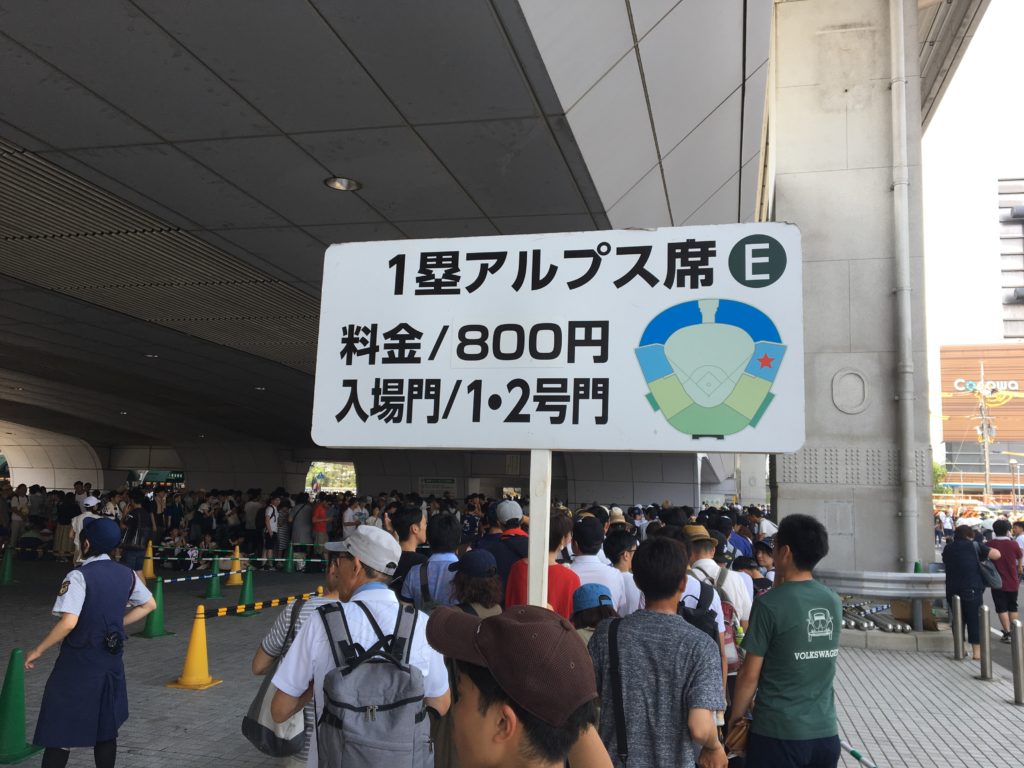
Am I ever going to get into the stadium? Was it a mistake to think I could pull this off?
Nearly exasperated, I tried one final stadium attendant… “Do you speak English?” “A little,” was the reply. To anyone who has been to Japan, finding a Japanese person who says they speak a little English, means that they actually speak a lot of English.
From my newest friend, I had finally found my ticket into the stadium. And by ticket, what I mean is that I found someone who could tell me how to get into the stadium…eventually. No, I wasn’t going to get into a game that day, I found, but if I came early the next morning, it’s possible that I could see a game. He explained to me that each line represents fans waiting to get into a specific section of the stadium. For Koshien seating, the stadium is broken into several parts – the outfield, the first base line and the third base line. Seating in the section behind home plate is for those who had purchased the limited number of tickets sold before the tournament. Each line weaves its way around Koshien Stadium terminating at a ticket window, where after waiting for hours in line, you are finally given the opportunity to purchase a ticket for the games that day. The ticket is good for all the games played on that day, usually three or four separate matches.
By the time I arrived at Koshien Stadium that day, it was well past noon. I knew that my chances of getting into a game that day were slim.
What time should I arrive tomorrow to get into the games? I asked.
“5 or 6 a.m. and you should be good,” he replied.
We briefly discussed musical instruments (more on that later), but it was time that I bid my friend “sayonara” and thank him for his assistance. I then hopped into one of the several shops surrounding Koshien to check out what merchandise was for sale before heading back towards Osaka.
Before settling into my hotel in Osaka, I took a small side trip to Nara. While the tournament is going on, it is almost as if the whole nation has a “kokoyakyu” fever (kokoyakyu is the Japanese phrase for “high school baseball”). On many Nara side streets, if you saw a group of people standing looking into a shop window, no doubt they are attempting to catch a glimpse of that day’s Koshien action. During its run, Koshien captivates Japan – it’s broadcast throughout the country on national TV. Even back in the States, I’ve been able to catch games using the “Sports Bull” app.
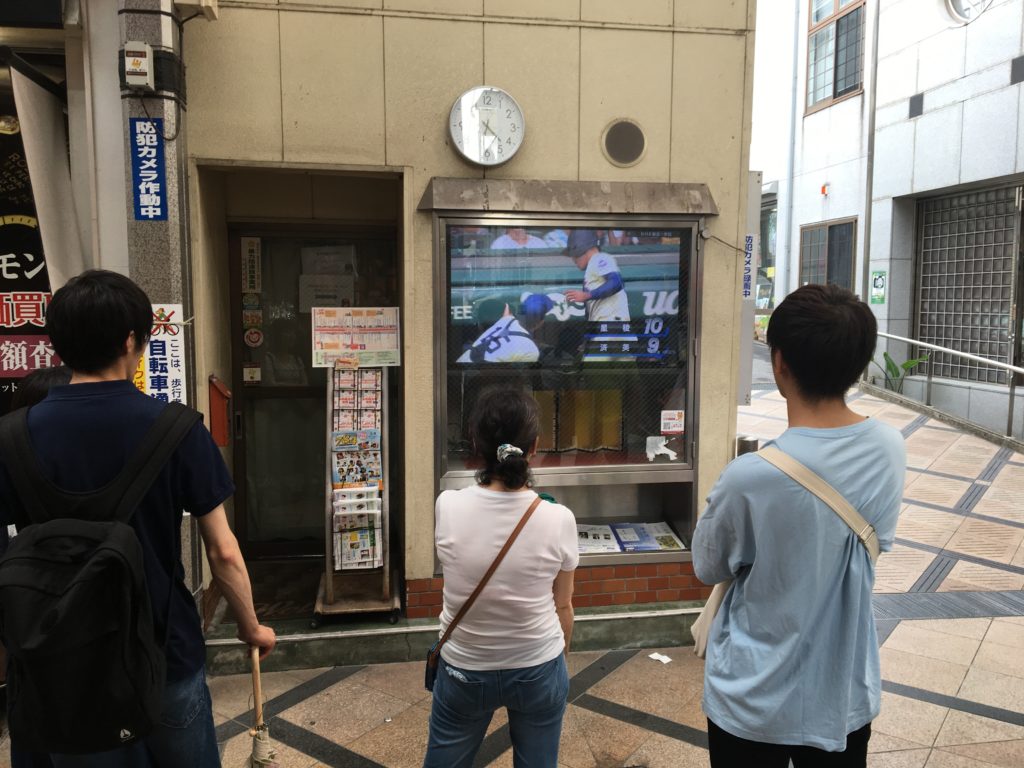
Act II – Part I – Monday, August 13, 2018 – 3:45 a.m. – A Second Attempt
Hearton Hotel & Koshien Stadium, near Osaka, Japan
3:45am the next day, my alarm went off. My excitement about the prospects of today’s games helped me quickly overcome my grogginess to get dressed, eat a small breakfast and be on my way. The prior evening, I had purchased a bag of snacks to take to the stadium – several Pocari Sweats (Japan’s answer to Gatorade), canned coffee, bags of peanuts, 7-11 pancakes (my personal favorite) and other food. I was ready to dig in and wait it out, hoping to get into the game at all costs. I didn’t come all this way for nothing, I thought.
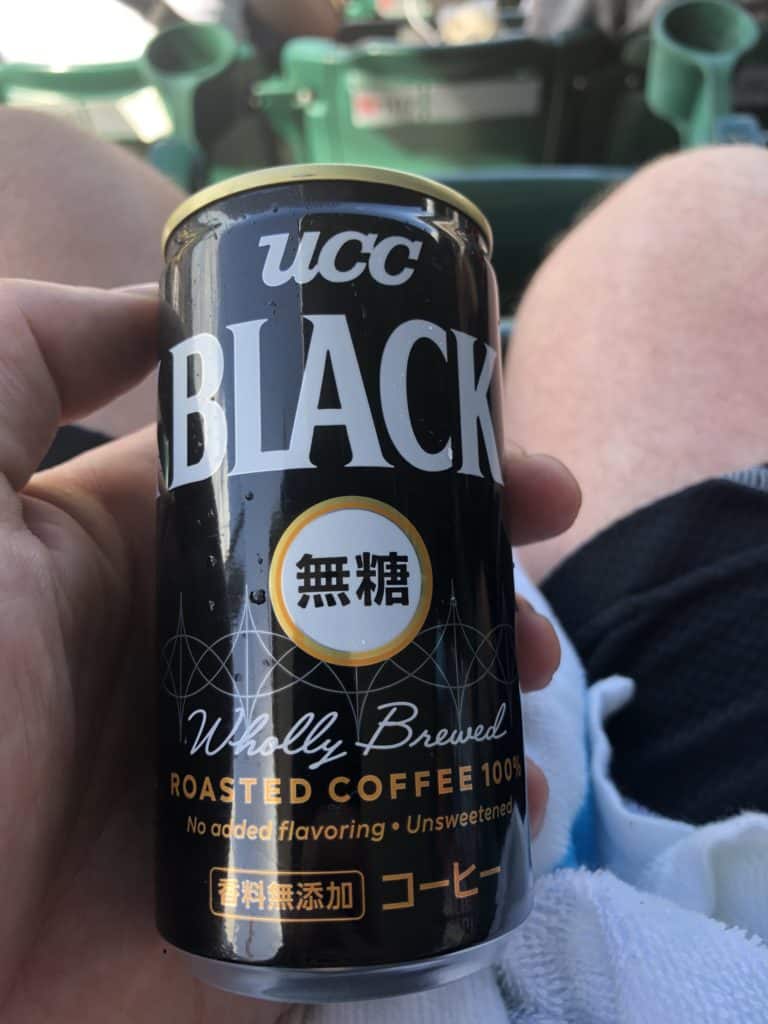
Trains to Koshien start running around 6am, but that would be too late for me on this day. I had the front desk of the hotel call for a taxi.
Ohayou gozaimasu a uniformed taxi driver quietly uttered several minutes later as he entered the hotel lobby. McGuire-san?
Yes, I replied as he showed me to the taxi, closing its door behind me. Koshien Stadium, I requested.
Koshien??! The driver said to me, looking in my eyes with a glint in his and a smile.
Koshien, hai.
And so began our early morning trip to the stadium, taking a combination of several side streets and highways. Along the way, I saw other Japanese baseball fans stumbling through the dark and quiet Osaka streets towards Koshien, holding, like me, their plastic shopping bag full of snacks for the day. During several of the cab rides I took while in Japan as the tournament progressed, the cab driver would often have the radio tuned to that day’s games, closely following the action.
I will admit that many “doomsday” scenarios ran through my head during the cab ride. I would soon be joining a long line full of non-English speakers. What happens if they run out of tickets? How will I know how long the wait will be until the next game? Will I just be waiting in this somewhat random line all day? And, more importantly – What if I need to go to the bathroom? Thankfully, though, I had strategically planned for the latter scenario by not drinking any liquids after using the rest-room at my hotel. At least I’ll have that covered…. maybe.
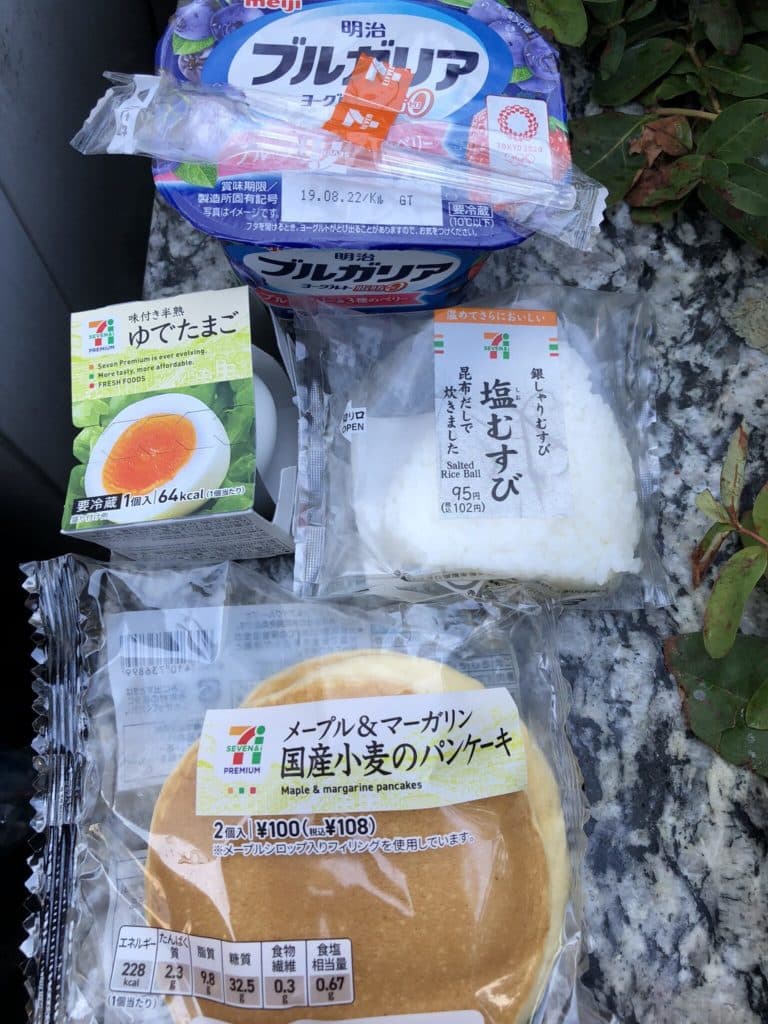
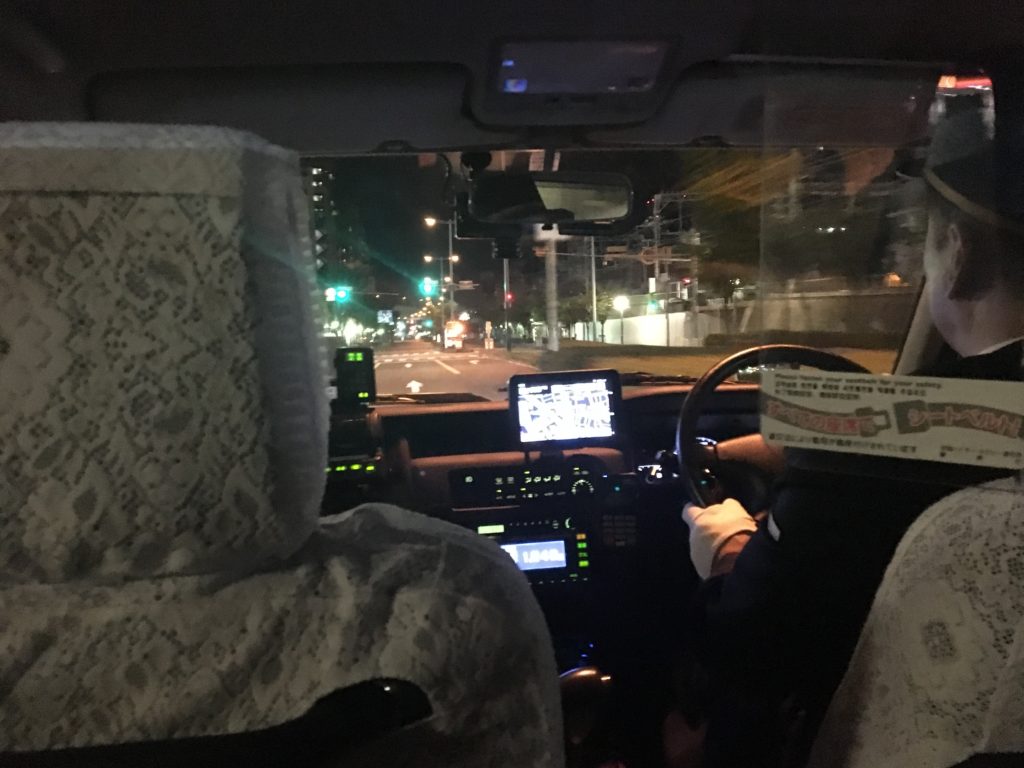
Around 5am, the driver dropped me in front of Koshien, wishing me well. Excitement began to well up inside of me as the taxi slowed, knowing that my quest to get into Koshien was about to begin. I was happy to see reasonable lines surrounding the stadium.
As I hopped out of the car, I set my sights on the outfield seating line, which was quickly growing long despite the early morning hour. I would later find out that a local team was playing that day in the first game – Osaka Toin. This would be another lesson to me – local team playing = long lines at the stadium. I followed the outfield ticket line as it wound around various corners and side streets, finally finding the end. I collapsed to the ground and settled in to wait, hoping that I did enough to get into the game that day.
My thoughts quickly returned to the prior day and my visit to Koshien’s merchandise shop. As all visitors to Japan can attest, the Japanese have a wonderful fascination with small souvenirs and knick-knacks. This shop at Koshien was evidence of that. Inside, you could buy anything you could ever dream of related to the Koshien Tournament – key chains, pencil sets, figurines, shirts, post cards and even collector Koshien cookie sets. My arms (and wallet) were overwhelmed – I had to shuffle back towards the store’s entrance to grab a basket. After nearly an hour of wandering through aisle upon aisle of merchandise, I finally found myself in front of the cash register. The cashier looked at my pile of knick-knacks that I had purchased, her lips curling into a small smile while making a laughing comment to the cashier next to her. The scene was probably quite amusing to them – an American in a sea of Japanese baseball fans, buying well over $200 worth of Koshien knick knacks. More than likely I was her best customer that day.
I was also able to find special Koshien merchandise at the local Koshien post office, where patrons can find a special “Koshien” stamp. During that year’s tournament, I was also able to buy a set of commemorative 100th year Koshien postage stamps. I’m not certain if this is something they sell every year or not, or was just a special occasion for the 100th Koshien.
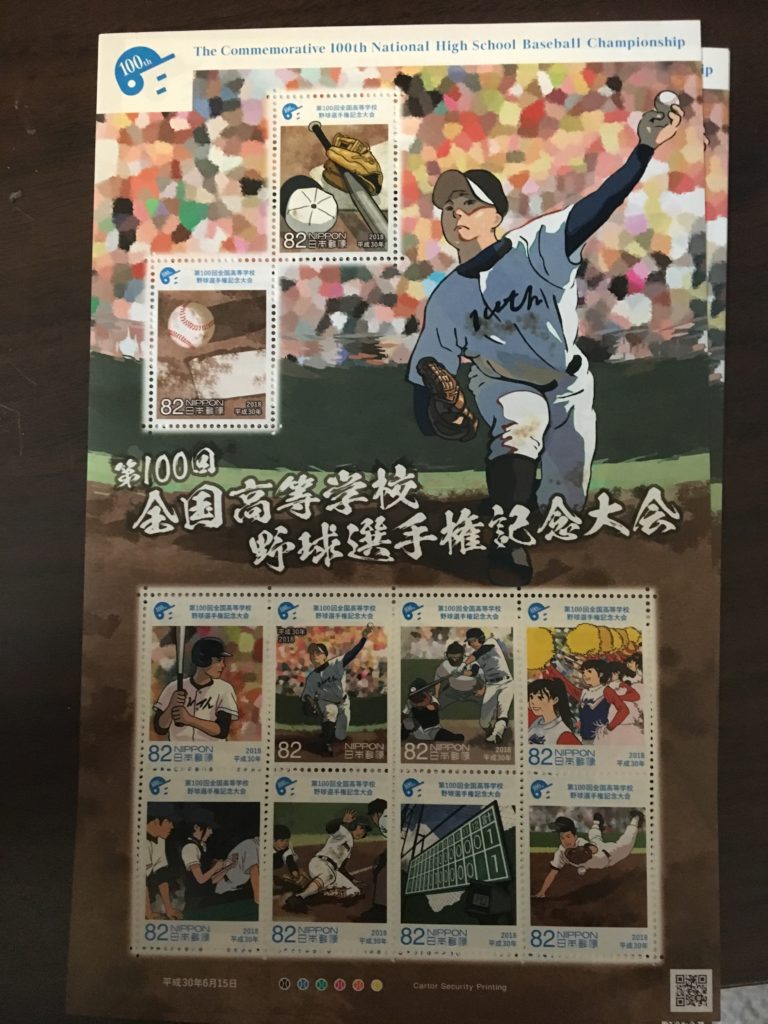
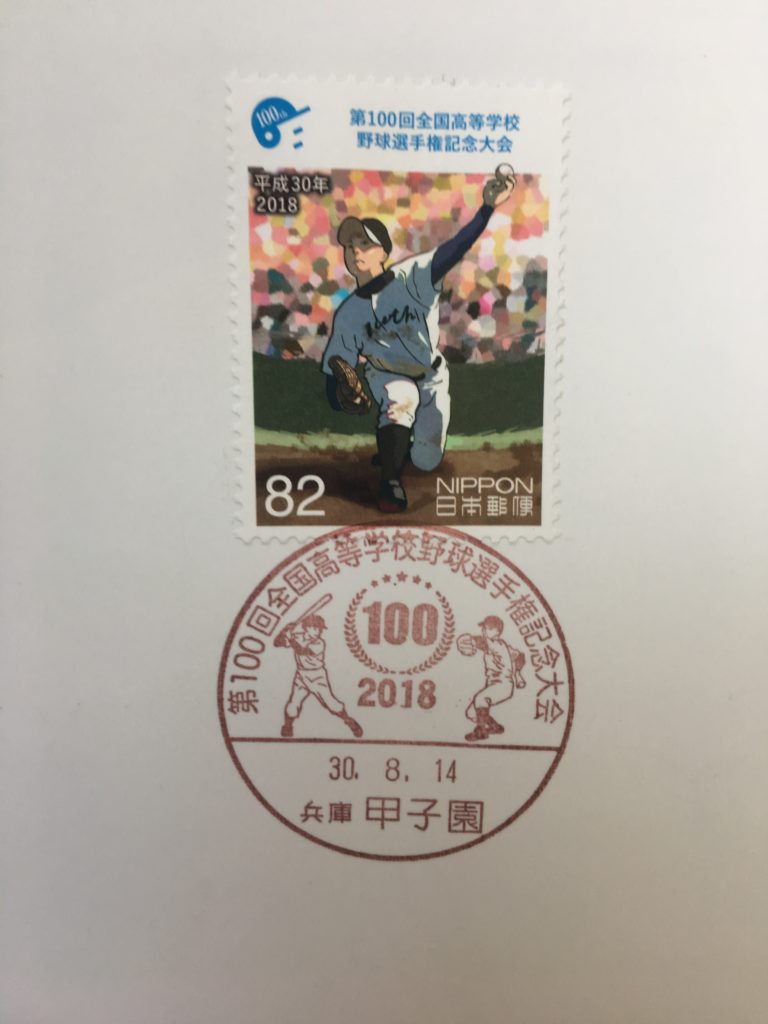
An ache from my legs slowly caused the store’s memory to evaporate and return me back to the present…. Sitting cross legged on a sidewalk outside of Koshien on an early Monday morning. The line had started to move.
Act II – Part II – Monday, August 13, 2018 – 7 am
It turns out that all my efforts paid off – the line moved quickly and, shortly afterwards, the ultimate destination was in sight – the ticket counter. I crossed the final barrier, holding up one finger to the ticket vendor, requesting one ticket for the outfield. It wasn’t long before I excitedly entered the stadium, the black dirt of Koshien appearing before me…. I was in.

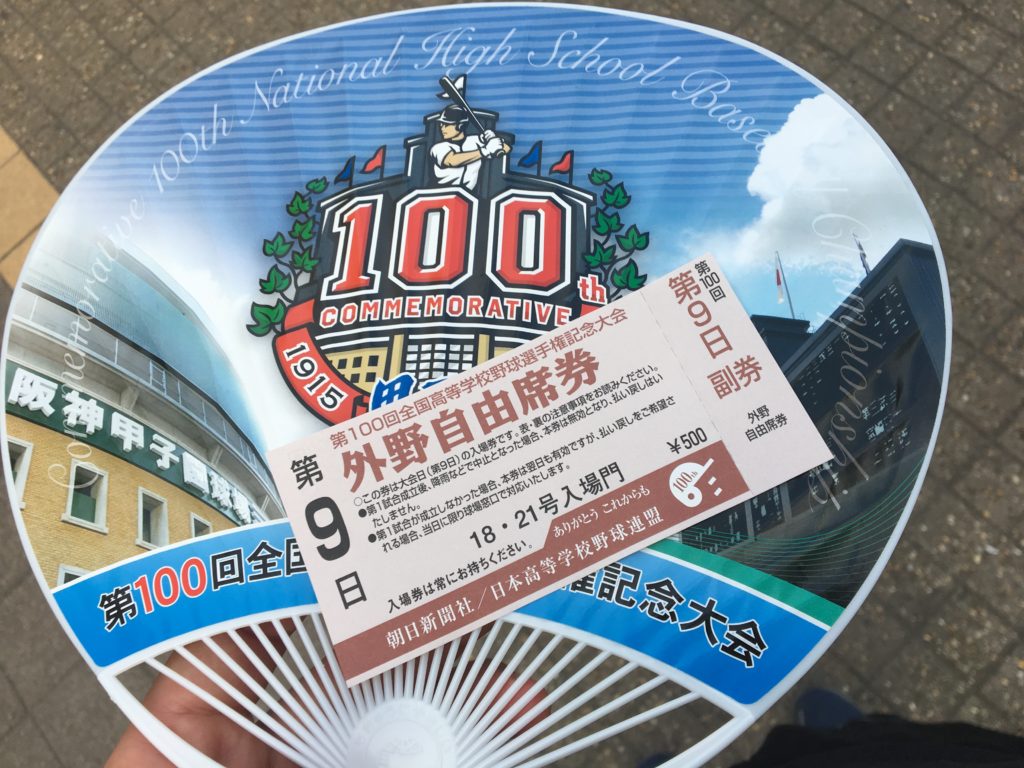

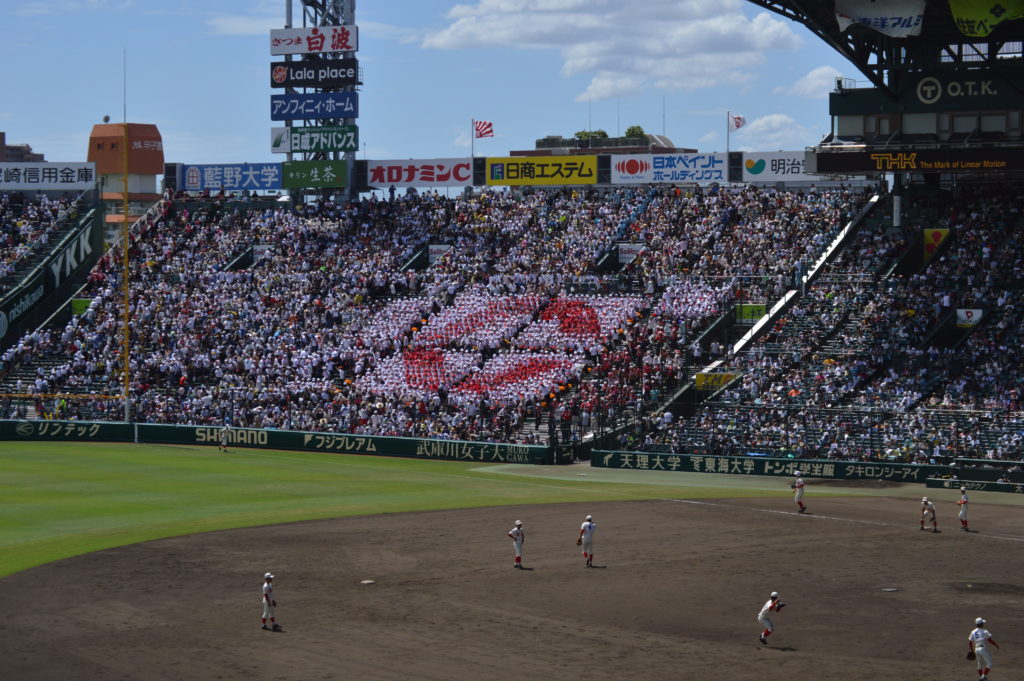
Japanese baseball fans oozed from every crevice of Koshien’s hallways as I made my way to the seating area. As I would soon find out, these fans rushed to the bleachers to place a towel on their preferred seat, “calling it” and then returned to the coolness (and shade) of Koshien’s lower passageways. This taught me one secret of how the Japanese indulge in Koshien – wake up early, call your seat, then find a cool spot to collapse and take a short nap before game time. Areas around air conditioners were in particular demand. Hungry, I grabbed a “real” Koshien ballpark breakfast of pizza, fries and noodles.
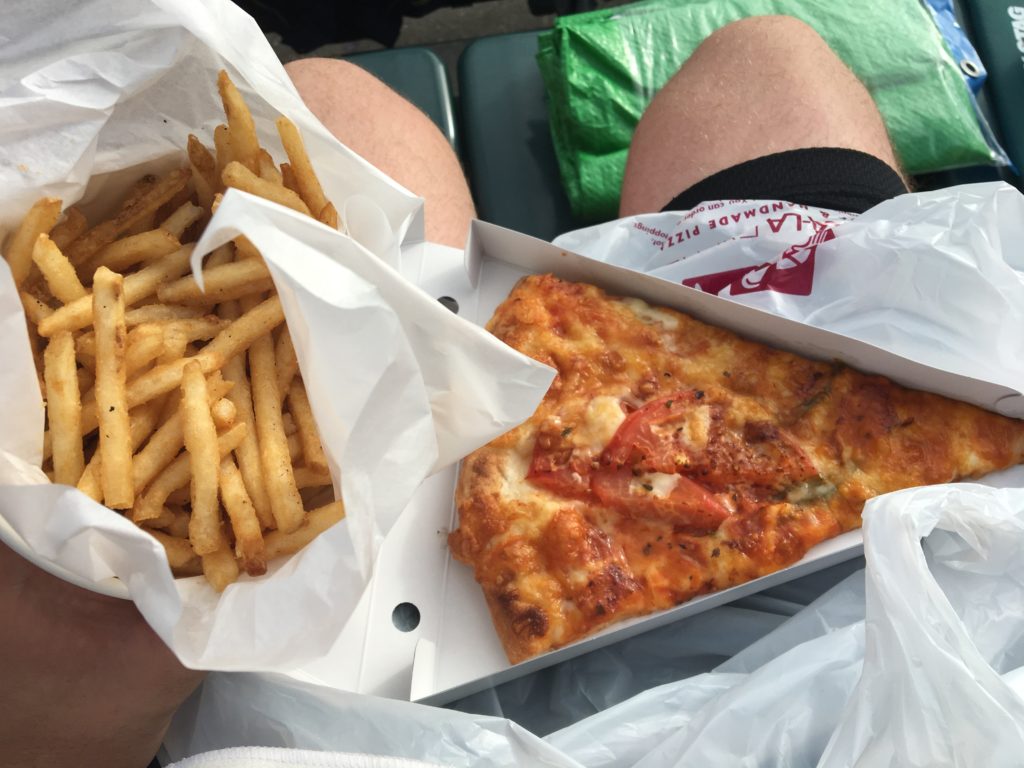

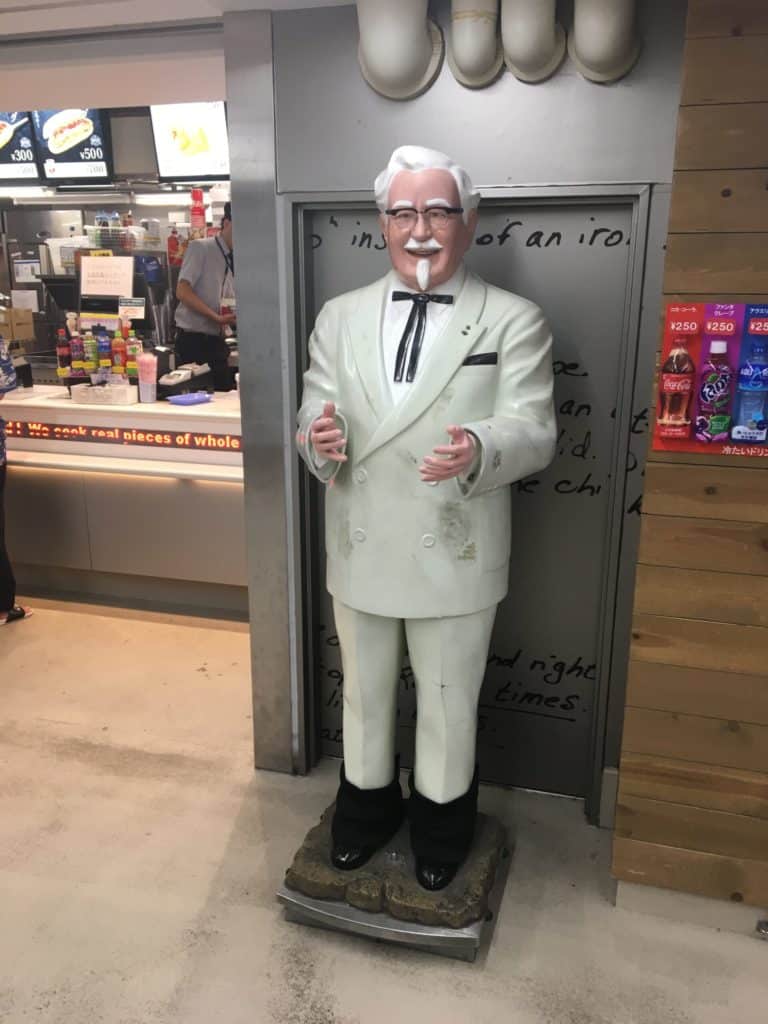
Act III – Later that day…. My first experience with Japanese High School Baseball
My outfield seat happened to be by an older Japanese man who had attended the day’s game by himself. We quickly began talking about Koshien and his experiences. He travels to attend as many games as he can, although his son has long since graduated from school. He says that the Japanese find solace in the purity, innocence and exuberance of Japanese high school baseball. That is why their uniforms are white, he said, it helps remind us of the purity of the players and game.
High school baseball in Japan is deeply rooted into Japanese culture, existing long before it became a professional sport. Several sources mention that baseball first came to Japan in the mid to late 1800’s, with many attributing the rise of the sport thanks to an American teacher who introduced students to the game. It wasn’t until the 1920s when the sport made its first attempt to become a professional sport. While that effort failed, what we know today as “Nippon Professional Baseball” (NPB) started in 1949, almost 90 years after its first introduction to Japan. The game has been in Japan so long that some Japanese are even rumored to think that their country invented baseball.
From my new friend, I was able to learn many things about the Japanese high school game and the differences between it and its US counterpart.
The gameplay itself is fast paced and exciting. Turnover between innings, which in American baseball is normally a leisurely long affair, is almost non-existent in Japanese high school baseball. The pitcher, having already warmed up on the side while his team was batting, only needs two or three warm-up pitches before the inning and play resumes. Another notable facet of Japanese high school baseball is the role that the players play in the game. Managers, or kantokus, are not allowed to step on the field of Koshien, which means that players must carry out all the roles and duties normally ascribed to adult coaches in the USA. Mound visits, coaching the bases and more are all handled by players on the team.
These players also seem to make every effort to get some of Koshien’s black dirt on their jerseys – sliding into first base at any opportunity. I’ve been told that the players also do this in order to show that they are making a full effort and are also trying to fire up their teams. They also make extra effort to leave the baseball respectfully at rest on the pitching rubber while switching from defense to offense. It was amazing to see the consistency among Japanese high school baseball teams in small details such as these.
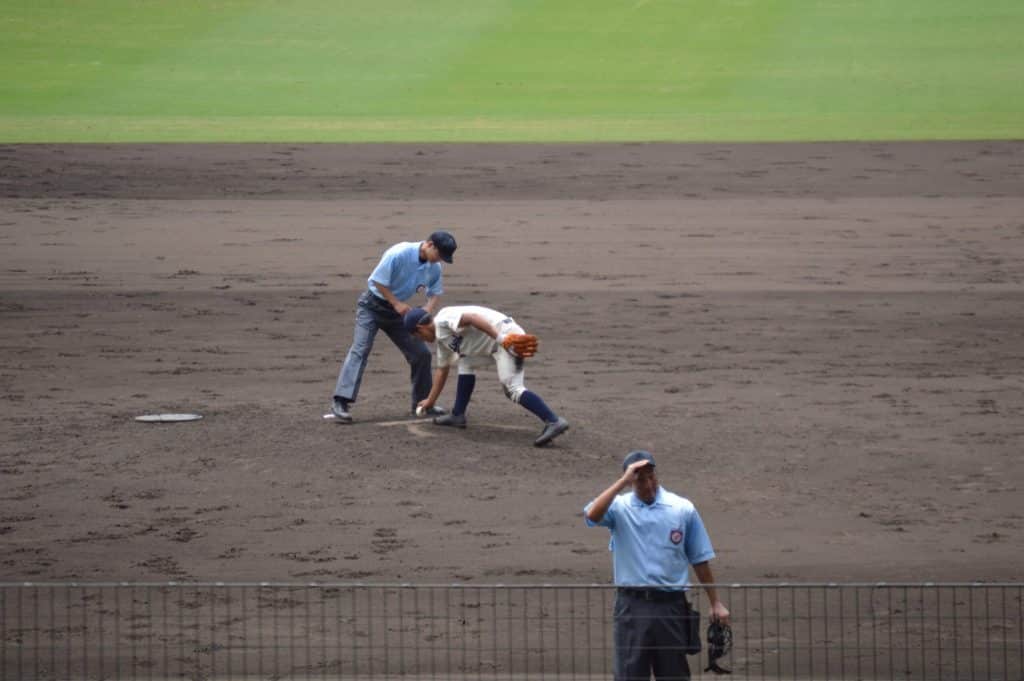
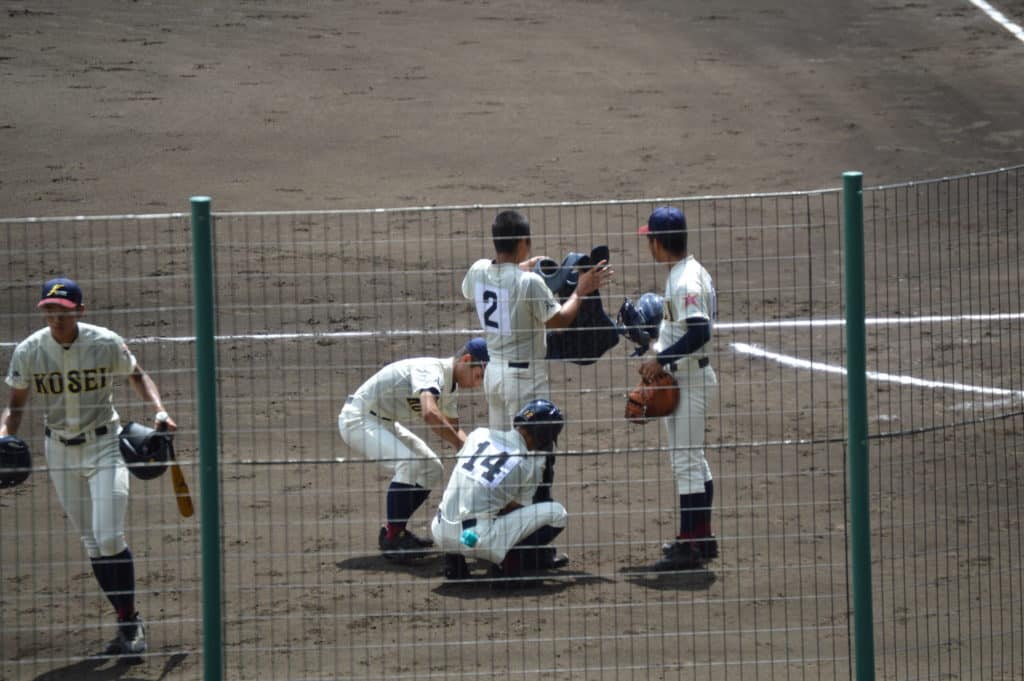
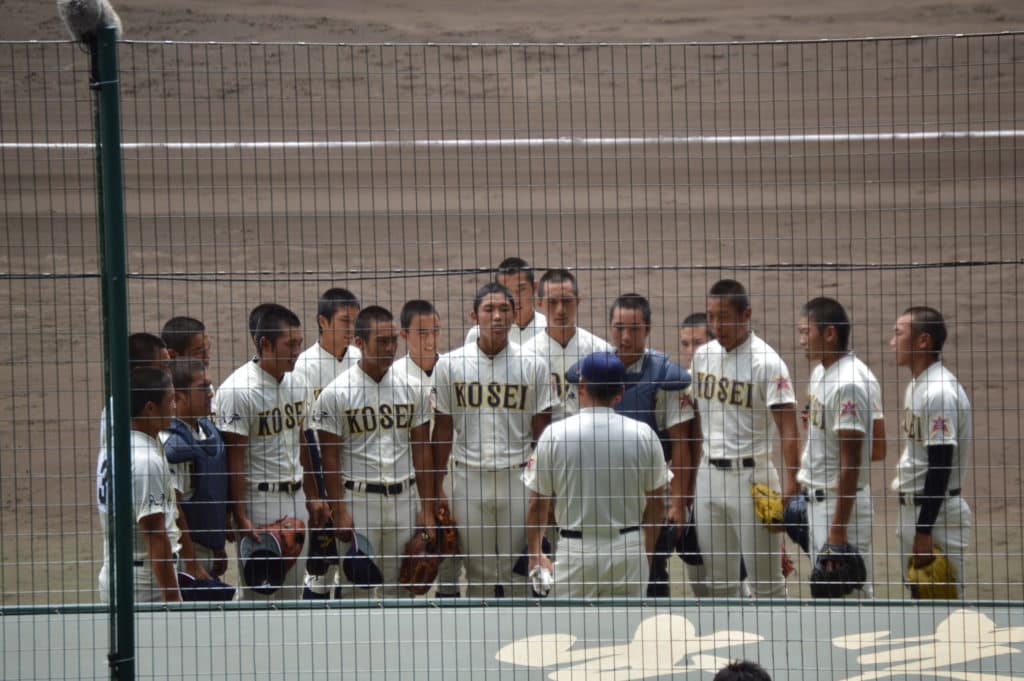
The infield/outfield routine, however, is for the coaches. Before the game, each team goes through their routine, getting in many reps before turning it over to their opponents. As I came to learn, each team is allotted a very short amount of time (6 minutes, if I remember correctly) to go through their entire infield/outfield routine. Given the time constraints, team coaches have also developed a very efficient ball exchange method, as you’ll see if you click on the videos below.
Returning to the game, there are many rituals to it – teams will normally bow to the field before and/or after taking their infield routine, they’ll then bow to their fans before and after the game, they’ll also go through another ritual of greeting the opposing team before and after the game. One of the final customs of a Koshien game is the losing team dropping to its knees and scooping handfuls of Koshien’s black dirt into their bags. Koshien is treated as a holy ground for these players, so the dirt they pulled from Koshien will remain with them as an important memento for the rest of their lives.
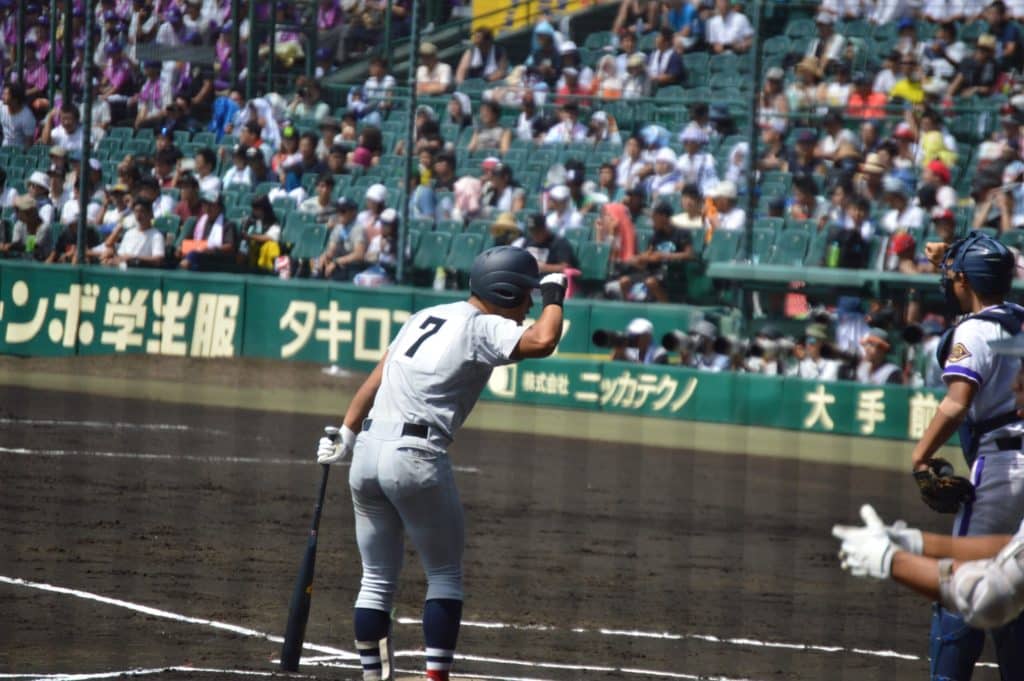

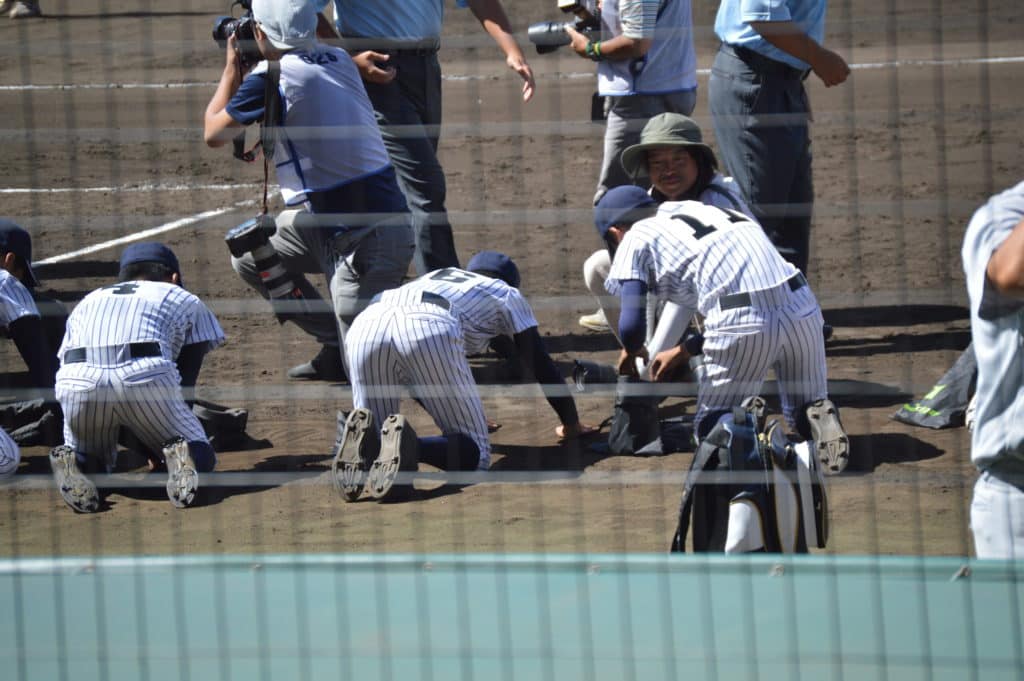
My friend and I watched all the games together that day. Throughout, I marveled at the “Bands of Koshien,” that play non-stop while their team bats. But, alas, as the last out was made, our time together had come to an end. We bid each other adieu and left Koshien. While attending games in the days after that, I often glanced into the outfield seats, catching small glimpses of my friend and his straw colored hat, taking in another day’s worth of Koshien.
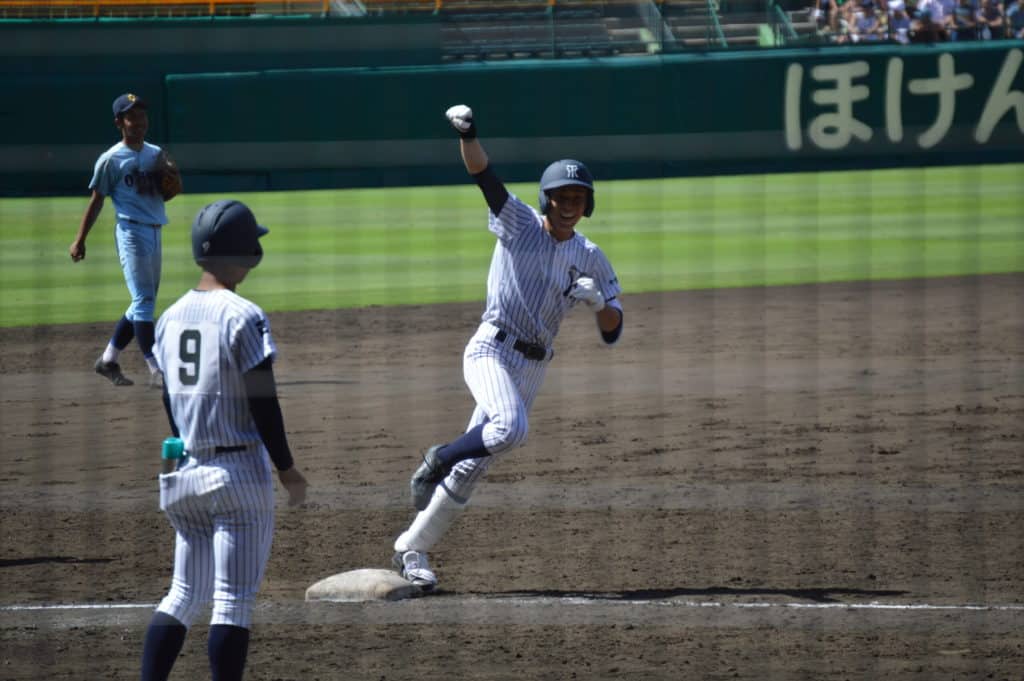
Act IV – Monday, August 12, 2019 – 7:30 am – A Return to Koshien
Koshien Stadium, near Osaka Japan
In 2019, I enlisted Michael Westbay of JapanBall Tickets to attempt to buy pre-sale tickets to the tournament. In general, all tickets are sold first-come, first-served on the day of the game. This helps support the dynamic nature of the tournament – it’s a single-elimination affair, similar to the NCAA’s “March Madness” basketball tournament in the United States. No team’s place in any game is guaranteed, thus selling tickets the day of the game helps suit the ever-changing tournament schedule. Despite a herculean effort, Michael was only able to secure tickets for the first day of the tournament – I think that should go to tell you how high the demand is for tickets!
When I arrived at Koshien that day, official tickets in hand, I was surprised to see another American standing near the entrance of Koshien, bucket hat on and towel around his neck. How did I know he was American? Well, his “Trader Joe’s” bag betrayed him. Turns out that his name is Glenn, he has lived and worked in Japan for many years and he tries to make it to as many Koshien games as his wife and family will allow. He did not yet have tickets for that day’s game and as game time approached, we had to bid farewell to one another as I needed to get into the stadium to my seats. On this particular day, I was attending the game with Fuji-san, someone very familiar to most Japanballers and whom I had met in Arizona at The Baseball Bureau’s Scout School the prior year. Fuji lives not far from Osaka, so it was a must that we attend Koshien games together that year.
As you saw before, if you do not have pre-sale tickets, the next advisable way to get a ticket is to arrive at Koshien several hours before game time and try your luck. Usually, you’ll have no issues getting tickets as long as you arrive early enough. It is possible to take the first train to Koshien and still arrive in time to get a ticket. It’s also possible to show up later in the morning and still find tickets available for one of the later games. The tournament usually starts around the first week of August and lasts for about two weeks after that. Getting tickets for the earlier rounds is easiest. Once the tournament field is narrowed to the quarterfinals, ticket lines become much longer as demand for the tickets rises.
There are usually three to four games played each day, the first of which starts at either 8am or 9am. From what I could see, the area with the most seating is the outfield section – so if you arrive late or a local team is playing, your best chance is to head towards the outfield line. I sat in both the 1st base and 3rd base sections as well – if you arrive early enough and have a little bit of luck, those tickets are usually obtainable. Once you get into the stadium, it’s open seating, so you can sit anywhere within your section.
Sun protection is a must! There is not much shade in Koshien and games are played all throughout the day in the stifling heat and humidty. It gets so hot that vendors sell bags of ice that come with a straw! After using the ice bag to cool yourself, the ice melts and you can then plug your straw into the bag and drink the melted ice.
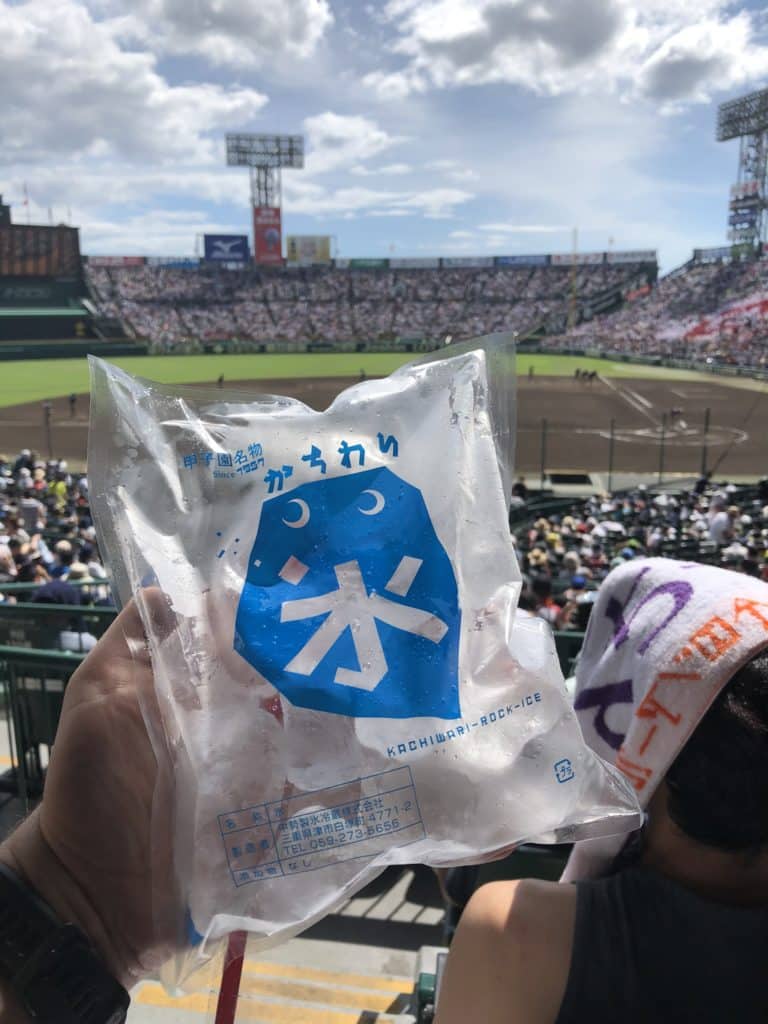
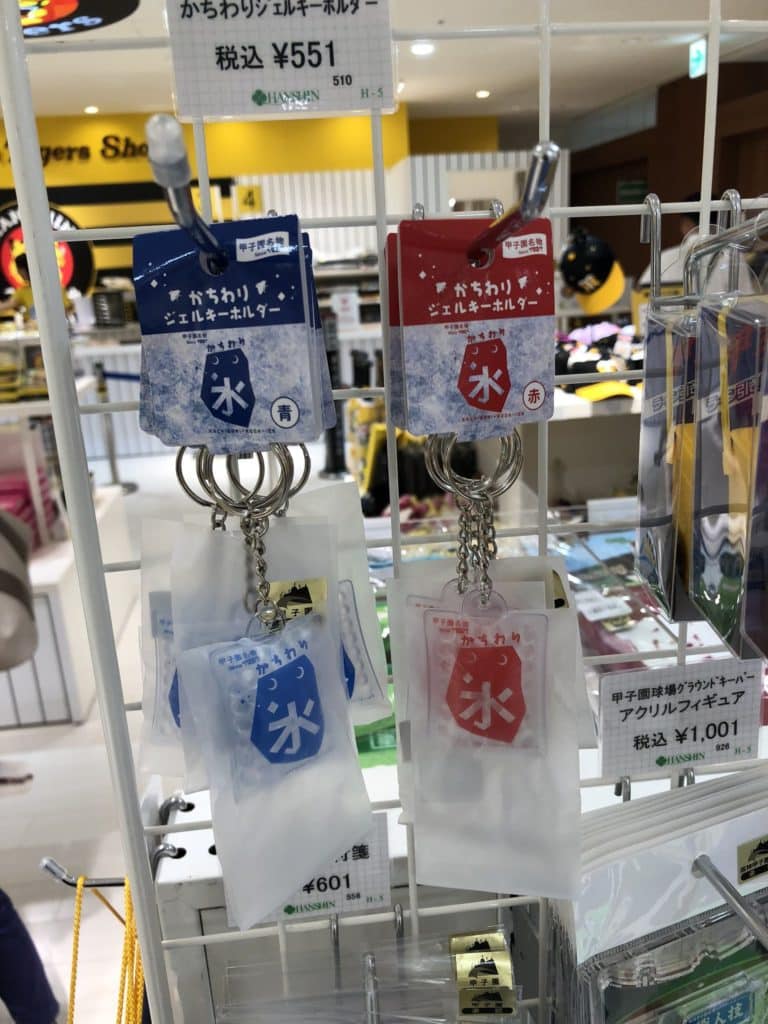
As Fuji and I took in that day’s games and I polished off my first bag of melted ice, I was surprised to see a familiar face walk into our section in front of us. Glenn! Amazingly, he had found a ticket in the coveted section behind home plate, which just happened to be our section!
I was able to get his attention, motioning for him to come sit in an open seat next to us. Little did I know that Glenn was about to drop a key knowledge bomb on me. Glenn related to me that another way to get tickets was to take advantage of the “gaijin effect.” As he explained, shortly after I left him, he remained in front of the stadium and, as he put it, tried to put a “lost” look on his face. Eventually, his “efforts” paid off in that someone came up to him and offered him a free, unused ticket into the game.
What makes this story even more amazing is that in the following days, I also made an attempt to make use of what I’ll call the “Glenn Maneuver” – arriving late at the stadium (tired after several days of early mornings and all day baseball) to try my luck near the gates with a plastic grocery bag of Koshien snacks in hand and my best “lost” look on my face. Sure enough, within several minutes, someone approached and asked if I wanted to attend the game! Scalping in Japan, as I’ve come to understand, is a bit taboo, but this new friend offered me his extra ticket at face value. Not only that, but we had exchanged contact information while in the stadium and within several minutes of departing one another, he had emailed me all kinds of information about the tournament and where to get food. If only he knew that by that time, I was a grizzled Koshien vet simply making use of a time honored way of securing difficult-to-come-by tickets…. The Glenn Maneuver.
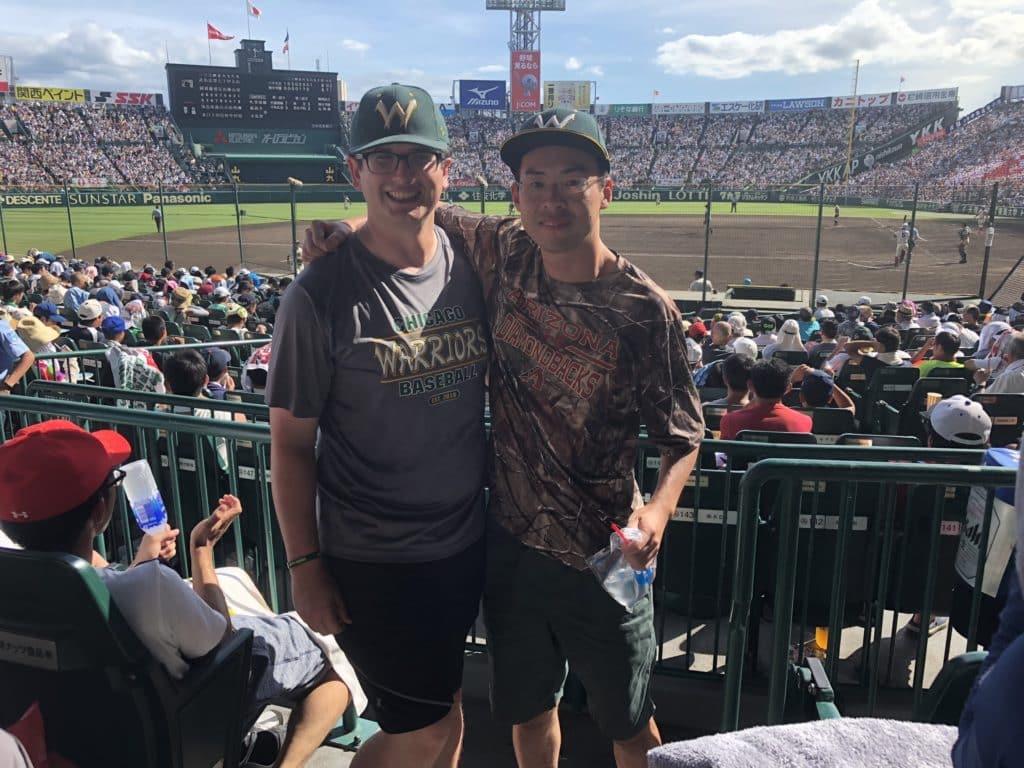
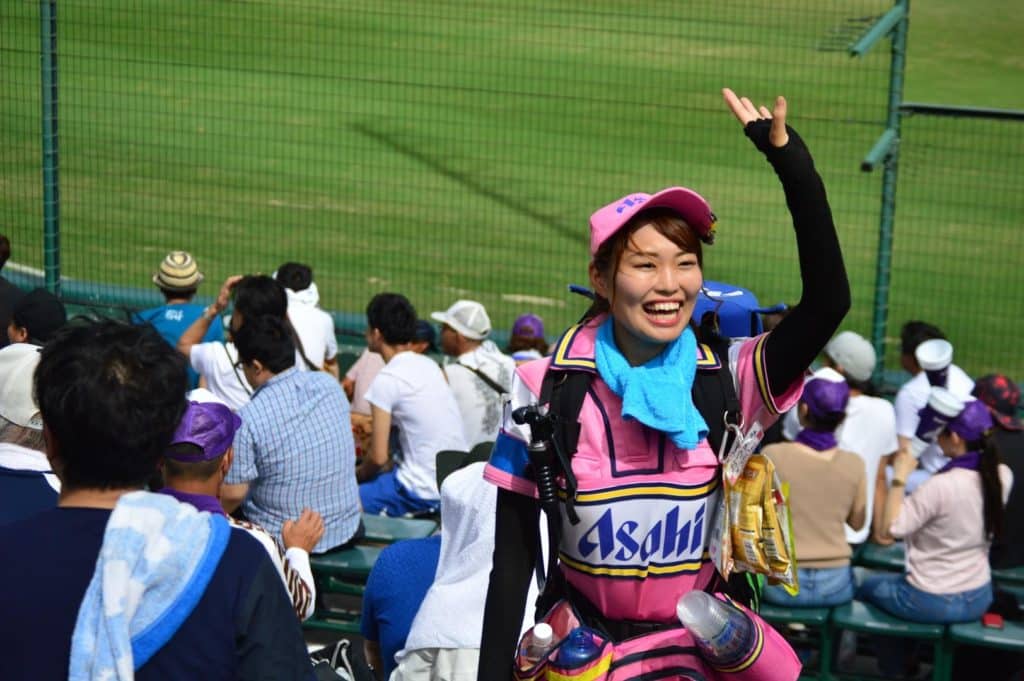
Act V – Wednesday, August 14th, 2019 – 1 pm – An Experience with the Oendan.
The weather on this day was a bit dour, but after one day of having tickets without having to wait in line and a second day where I was given tickets through The Glenn Maneuver, I decided to head out to Koshien Stadium once again to see what I could learn about some of the other seating areas of Koshien. An approaching typhoon appeared to have scared off many Koshien fans that day, as the lines were short when I arrived. Offered a choice of several lines to wait in, I decided to try my luck at trying to get into one of the special sections specially designated for participating schools’ oendans, or official fan groups that lead songs and cheers.
The prior year, my security guard friend had told me that you needed to bring an instrument, such as a trumpet or trombone to get into this sort of section, which is located just beyond the 1st or 3rd base line seats, but before the outfield seating begins. Actually, he never specifically said the words “trumpet” or “trombone” but made motions in front of his face, mouth and body that suggested as much. Unfortunately, airline carry-on restrictions prevented me from bringing my musical instrument with me that year, but I tried my luck anyway to get into the section. Turns out that there must have been a small cultural misunderstanding between me and my friend, as I was not asked “sumimasen, where is your instrument” when I purchased a ticket to this section. I was quickly in the stadium and right in the middle of a boisterous cheering section for “Narasino,” a high school near Tokyo.
There were no seats to be found in the section, so I ended up standing near the Narasino band. Band tunes played at Koshien are normally varied – ranging from Japanese classics to modern pop hits. Not for Narashino, though. For them, it was the same driving march, over and over…. and over…. punctuated by a cheer of “Narasino.” The french horn players wore wide-brimmed hats and attached towels to their instruments to prevent their fingers from burning on the hot metal. It was intense. The bands are sometimes led by the students, but Narasino’s band was slightly different in that its main antagonist appeared to be an older man that stood in front of the sousaphones. His serious stare at the action unfolding in front of him was occasionally interrupted by him shouting corrections to the surrounding brass players.
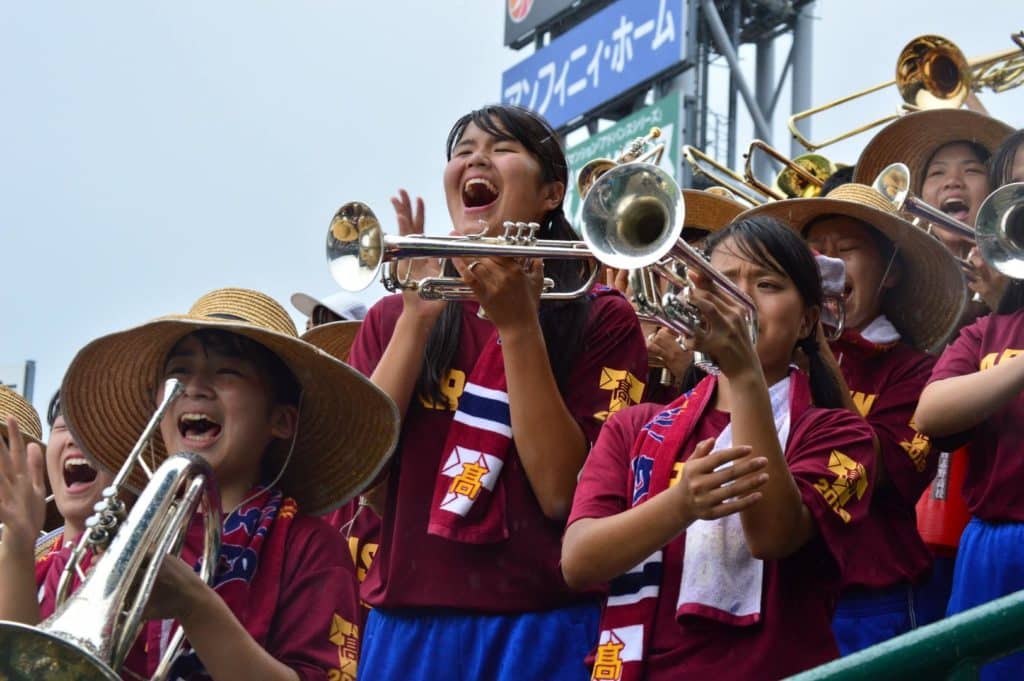
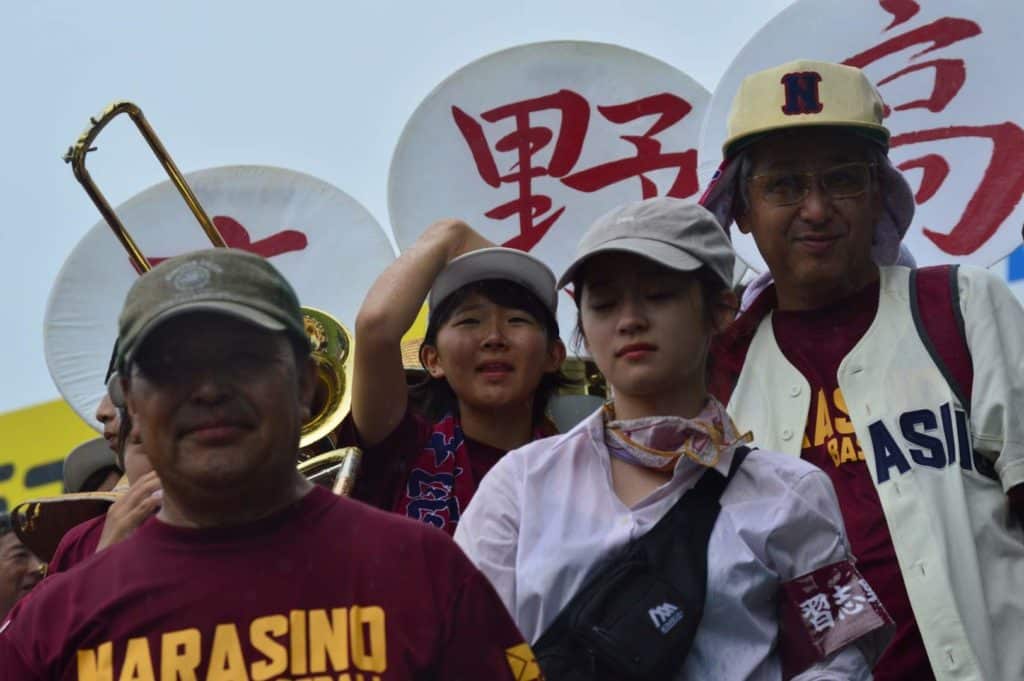
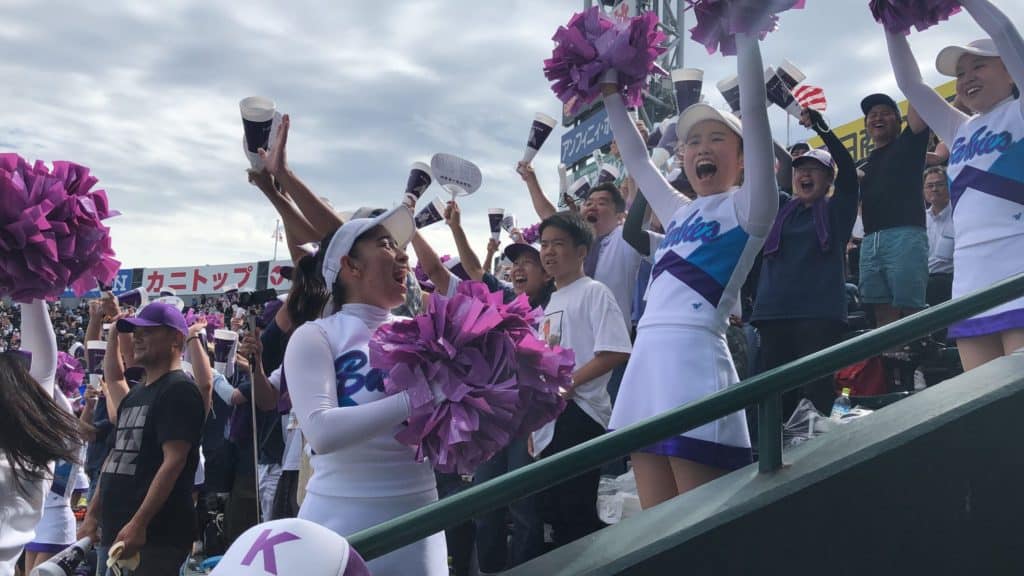
The seriousness of this man was offset by memories of another band the day before. One of the players in particular who I happened to sit across from, cheerfully played a soprano saxophone, belting out hits such as the theme from “The A-Team,” pleasant classical Japanese, and Queen.
Back to Narasino. Its fans also gave off an air of seriousness, ignoring my attempts to take any one of the few open seats that I could spot. I resolved myself to standing for this game until the Narasino fans filed out after their defeat, allowing me to grab a prime seat for the next game.
Act VI – Friday, August 16th, 2019 – A Final Day at Koshien
After my experience with the Oendan, the typhoon cancelled Thursday’s Koshien games, leaving me only one more day of Koshien before I had to depart back towards Tokyo to spend a few days there and in Kanazawa, then back to Tokyo to catch my flight back to the USA.
Friday happened to be some of the final games before the quarterfinals, semi-finals and then finals of the tournament. The Koshien tournament is a culmination of a larger tournament entered by nearly 4,000 Japanese high school teams from across Japan. Play starts with prefectural tournaments, the winners of which eventually advance to face off against one another at Koshien. One team is eventually crowned champion of the Koshien tournament each year. Players who play in the tournament and have heroic performances, especially pitchers, are remembered for the rest of their lives. It has been said that a player’s historic Koshien performance will follow that player for the rest of their playing career, sometimes overshadowing any future achievements in the professional ranks.
Wikipedia’s page on Japanese high school baseball includes a decent summary of the tournament, plus notable players who first made their names at Koshien – available here. Also note the article’s reference to “Spring” Koshien. Summer Koshien is the most famous edition of the yearly Koshien tournament, but a similar (but less popular) version of the tournament is also held each Spring.
It is always a sad moment for me when the last Koshien pitch of my last Koshien game is thrown and the final out is made. The walk down Koshien’s steps is slow, as tractors re-work Koshien’s black dirt, preparing it for the next day’s competition. I always take my time walking out of Koshien for the final time, marveling at the controlled mess at each recycle bin – hundreds of neatly stacked bottles almost standing guard against one another.
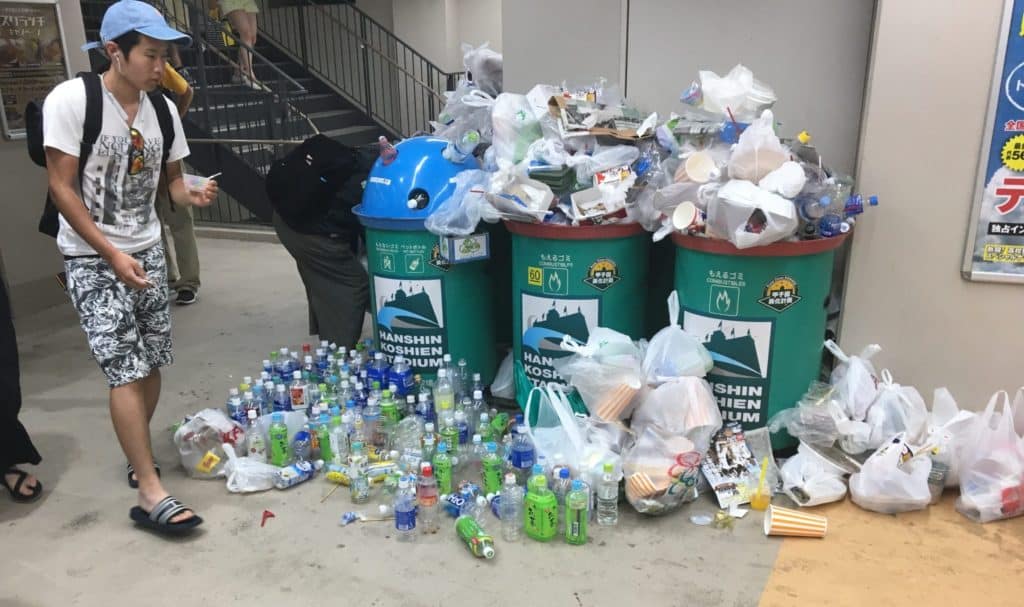
Speaking of guards, as you walk out, you may catch a glimpse of security shaking folks awake who “had too much Koshien” and decided to pass out in front of an air conditioner. Too many early mornings, too much baseball, beers, heat or sun, or a combination of all of the above, can catch up to some folks. You also get the sense while spending time at Koshien that there are definite “Koshien Pros” at work – meaning folks who are being paid to wait in line, buy tickets and save seats inside Koshien on behalf of more wealthy clients. Thankfully, though, this type of activity didn’t appear to be too prevalent but I would definitely come across people who were not your regular, run-of-the-mill Koshien fans.
Koshien pros or not, outside the stadium at the end of day of Koshien, I would inevitably see fans already lined up for the next day’s games, tickets not to go on sale until an hour before the game the following morning. One time, I actually exited the stadium with a guy who promptly got right back in the ticket line for the next day’s tickets (sure sign of a Koshien Pro). But, there are even women and children hunkering down outside of Koshien, true Koshien fans, prepared to spend a night on the concrete in order to get the best tickets for the quarterfinals. Hopefully they don’t have to go to the bathroom.
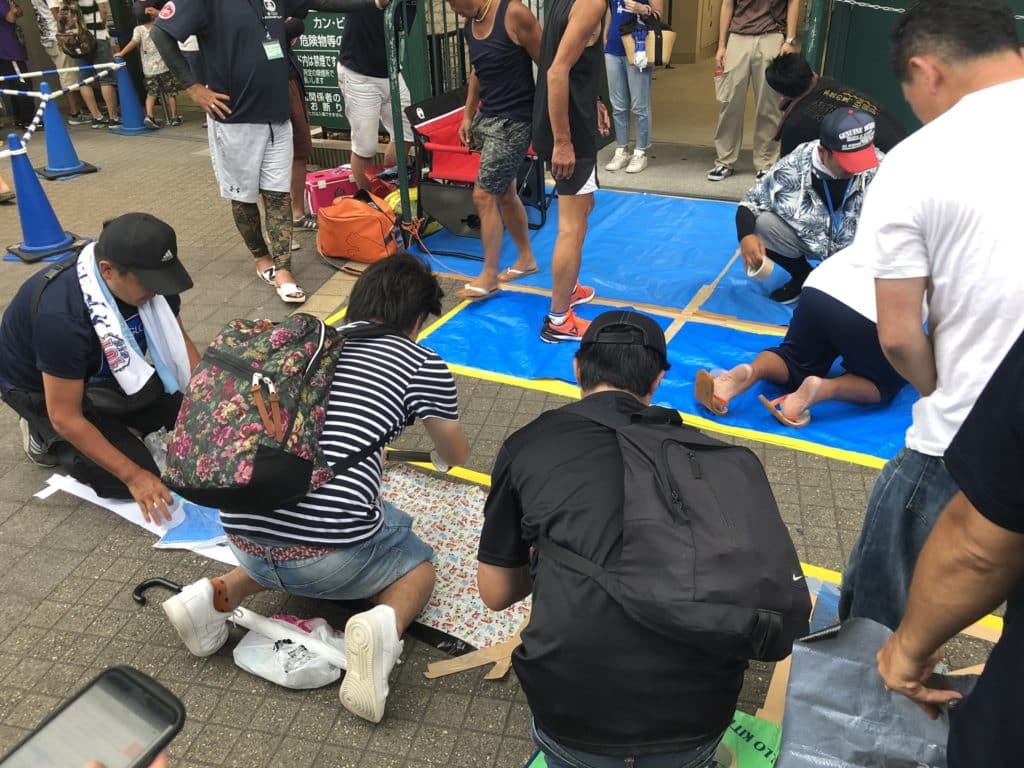
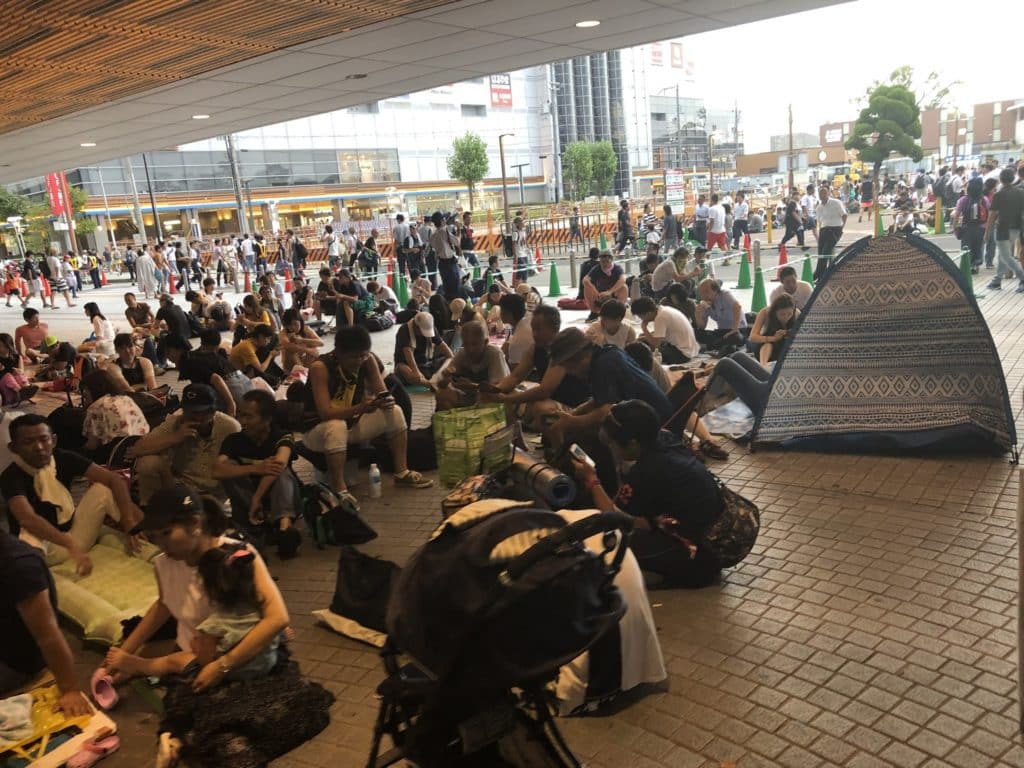
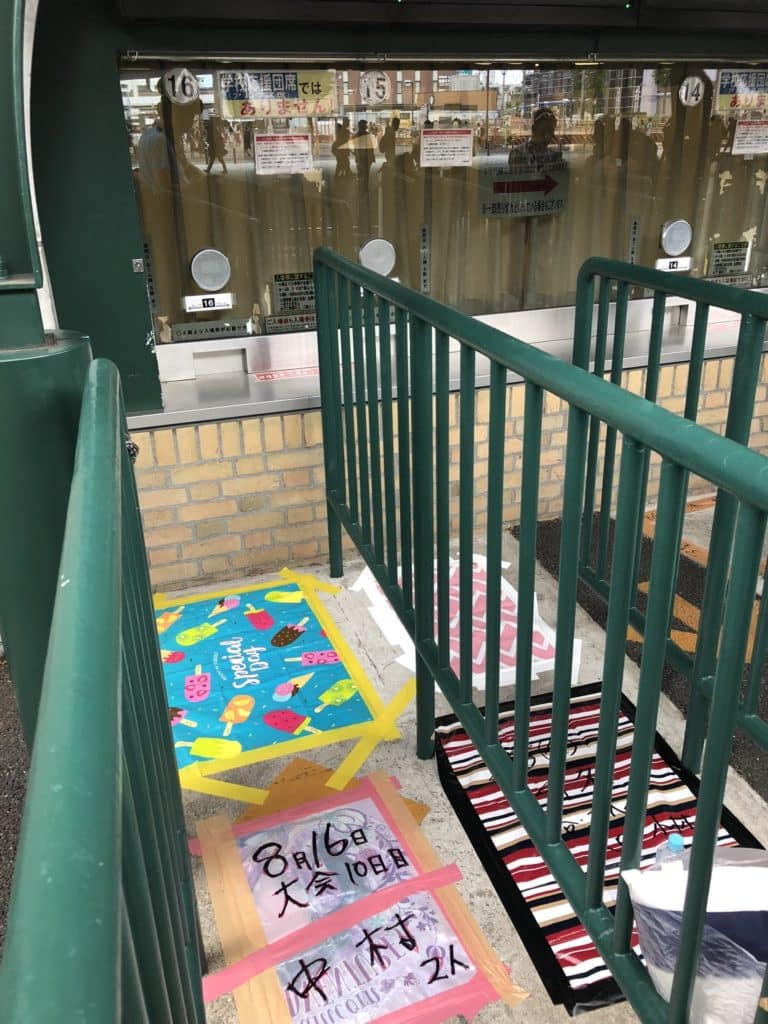
Further Resources –
Documentary:
Free documentary: High School Baseball in Japan – Kokoyakyu (available on YouTube)
Robert Whiting’s “You Gotta Have Wa”, Chapter 11 – The Schoolboys of Summer (JapanBall receives a commission if you use this link)
In Japan, 100 Years of Glory Days for High School Baseball New York Times
For more Japanese baseball, check out JapanBall’s Articles and Features section!










5 comments
Thoroughly enjoyed your piece on Koshien. I attended my first tournament more that 50 years ago while living in Tokyo, working on the ’64 Olympics. My love affair with Japan, particularly the baseball, is everlasting.
Good job on your story and hope you have more chances to Koshien.
Aloha,
Don Robbs
Honolulu
JapanBall Hall of Fame
Thanks, Don! Wow, that is so great that you got to see Koshien back then. I bet it has hardly changed at all since the 60s.
Oh wooowww…. I was there as well in 2018, but I went in August 7th, during the earlier round! I knew there had to be another gaijin than me coming to watch the spectacle!
That was my first time ever watching baseball live in stadium (baseball is non-existent where I came from), but it was electric. Loved the experience!
That is so great that you were able to go! What an amazing experience.
Hello Tom,
It’s a wonderful article that you wrote here for non-Japanese. I can really feel what you described as I’ve attended a Tigers game last year.
Your story made me want to go to Koshien, and that’s what I’m trying to do for the 106th edition, for the 100th anniversary of the Koshien stadium.
To prepare myself I’m reading an re-reading the famous manga about Koshien to get in the vibe.
Hopefully I’ll be able to buy an advance ticket to the opening ceremony.